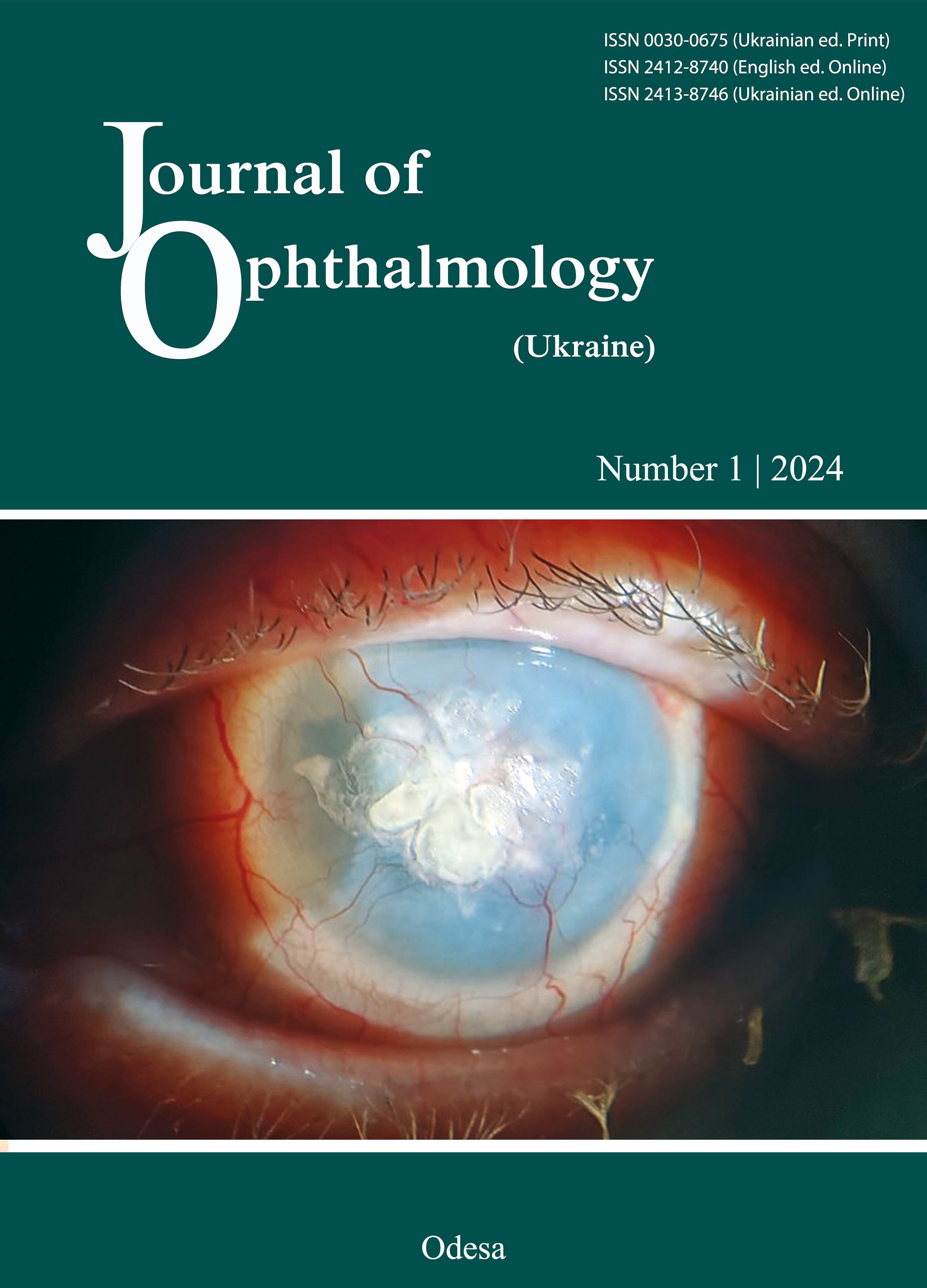Retinal function as assessed by multifocal electroretinography and central perimetry before and after vitrectomy with conventional versus fovea-sparing internal limiting membrane peeling for idiopathic macular hole
DOI:
https://doi.org/10.31288/oftalmolzh202414453Keywords:
vitrectomy, optical coherence tomography, idiopathic macular hole, internal limiting membrane, multifocal electroretinography, automated static perimetryAbstract
Purpose: To perform multifocal electroretinography (mfERG)- and central perimetry-based evaluation of the function of the macula before and after vitrectomy with conventional internal limiting membrane (ILM) peeling versus fovea-sparing ILM peeling for idiopathic macular hole (IMH).
Material and Methods: This study included 70 patients (71 eyes) who received 25-G vitrectomy with conventional or fovea-sparing ILM peeling and gas tamponade with 20% SF6 or 15% С3F8 for stage-2 to stage-4 holes as per the classification by Gass. Eyes of study patients underwent optical coherence tomography angiography (OCTA) evaluation of IMH diameter and choriocapillaris perfusion density, ten-degree static perimetry and 20-degree 5-ring mfERG before and 1 month after surgery.
Results: Before surgery, eyes with IMH showed significantly reduced foveal light sensitivity and overall parafoveal sensitivity, increased Pattern Standard Deviation (PSD), and reduced retinal response density in mfERG rings 1 and 2 compared to fellow eyes. The foveal threshold sensitivity in the affected eyes was found to be correlated with minimal diameter of IMH (r = -0.77; р < 0.05) and the postoperative BCVA (r = 0.66; р < 0.05), whereas the overall retinal sensitivity, with the maximal diameter of IMH (r = -0.56), preoperative BCVA (r = 0.6) and postoperative BCVA (r = 0.7). MfERG retinal response density in ring 1 was significantly reduced (р = 0.00001) and correlated with the preoperative foveal threshold sensitivity (r = 0.6) and choriocapillaris perfusion density (r = 0.39). After macular hole closure, median BCVA (interquartile range) in the fovea-sparing ILM peeling group and the conventional ILM peeling group improved to 0.55 (0.35–0.7) and 0.43 (0.35–0.6), respectively. In addition, the foveal threshold sensitivity within 10-degree area in the former and latter groups improved, but was 13.6% (р = 0.009) and 15% (р = 0.0001), respectively, lower than in the fellow eyes (34.5 ± 2.9 dB). The overall retinal sensitivity in the fovea-sparing ILM peeling group improved more substantially, to 509.6 ± 13.9 dB, and almost reached the fellow-eye value (528.0 ± 25.8 dB). Moreover, the retinal response density in the conventional ILM peeling group improved in rings 1-5, whereas that in the fovea-sparing ILM peeling group, in rings 2-4, but not in ring 1.
Conclusion: In eyes with IMH, retinal photoreceptor function as assessed by perimetry and mfERG was found to be impaired at baseline and improved after macular hole closure. In the fovea-sparing ILM peeling group, the overall retinal sensitivity in the affected eyes improved more substantially than in the conventional ILM peeling group.
References
McCannel CA, Ensminger JL, Diehl NN, Hodge DN. Population-based incidence of macular holes. Ophthalmology. 2009;116(7):1366-1369. https://doi.org/10.1016/j.ophtha.2009.01.052
Cornish KS, Lois N, Scott N, Burr J, Cook J, Boachie C, et al. Vitrectomy with internal limiting membrane (ILM) peeling versus vitrectomy with no peeling for idiopathic full-thickness macular hole (FTMH). Cochrane Databas Syst Rev. 2013 Jun 5:(6):CD009306. https://doi.org/10.1002/14651858.CD009306.pub2
Murphy DC, Fostier W , Rees J, Steel DH. Foveal sparing internal limiting membrane peeling for idiopathic macular holes: effects on anatomical restoration of the fovea and visual function. Retina. 2020 Nov;40(11):2127-2133. https://doi.org/10.1097/IAE.0000000000002724
Ho TC, Yang CM, Huang JS, Yang CH, Chen MS. Foveola nonpeeling internal limiting membrane surgery to prevent inner retinal damages in early stage 2 idiopathic macula hole. Graefes Arch Clin Exp Ophthalmol. 2014 Oct;252(10):1553-60. https://doi.org/10.1007/s00417-014-2613-7
Morescalchi F, Russo A, Bahja H, Gambicorti E, Cancarini A, Costagliola C, et al. Fovea-sparing versus complete internal limiting membrane peeling in vitrectomy for the treatment of macular holes. Retina. 2020 Jul 40(7):1306-1314. https://doi.org/10.1097/IAE.0000000000002612
Lai TY, Chan W-M, Lai RY, Ngai JW, Li H, Lam DS. The Clinical Applications of Multifocal Electroretinography: A Systematic Review. Surv Ophthalmol. 2007 Jan; 52 (1):16-95. https://doi.org/10.1016/j.survophthal.2006.10.005
Poloschek CM, Sutter EE. The fine structure of multifocal ERG topographies. J Vis. 2002 Feb; 2(8):577-87 https://doi.org/10.1167/2.8.5
Heijl A, Patella VM, Bengtsson B. The Field analyzer primer: effective perimetry. 4th ed. Carl Zeiss Meditec Inc., Dublin, CA; 2012.
Gass JD. Reappraisal of biomicroscopic classification of stages of development of a macular hole. Am J Ophthalmol. 1995 Jun 119(6):752-9. https://doi.org/10.1016/S0002-9394(14)72781-3
Buallagui I, Rozanova ZA, Nevska AO, Umanets MM. Optical coherence tomography angiography features of the chorioretinal complex and choriocapillaris perfusion before and after vitrectomy with conventional versus fovea-sparing internal limiting membrane peeling for idiopathic macular hole. J Ophthalmol (Ukraine). 2023;6(515):4-10. https://doi.org/10.31288/oftalmolzh20236410
Buallagui I, Rozanova ZA, Umanets MM. Surgical treatment of idiopathic macular holes with a fovea-sparing technique and 20% SF6 gas tamponade. J Ophthalmol (Ukraine). 2023;4(513):21-25. https://doi.org/10.31288/oftalmolzh202342125
Umanets MM, Rozanova ZA, Khramenko NI, Nevska AO, Buallagui I. Anatomical and functional outcomes of idiopathic macular hole surgery with fovea-sparing versus conventional internal limiting membrane peeling. J Ophthalmol (Ukraine). 2023;5(514):3-10. https://doi.org/10.31288/oftalmolzh20235310
Nakamura T, Murata T, Hisatomi T, Enaida H, Sassa Y, Ueno A, et al. Ultrastructure of the vitreoretinal interface following the removal of the internal limiting membrane using indocyanine green. Curr Eye Res. 2003;27(6):395-399. https://doi.org/10.1076/ceyr.27.6.395.18189
Gelman R, Stevenson W, Prospero Ponce C, Agarwal D, Christoforidis JB. Retinal damage induced by internal limiting membrane removal. J Ophthalmol. 2015;2015:939748. https://doi.org/10.1155/2015/939748
Lim JW, Kim HK, Cho DY. Macular function and ultrastructure of the internal limiting membrane removed during surgery for idiopathic epiretinal membrane. Clin Exp Ophthalmol. 2011;39(1):9-14. https://doi.org/10.1111/j.1442-9071.2010.02377.x
Mitamura Y, Ohtsuka K. Relationship of dissociated optic nerve fiber layer appearance to internal limiting membrane peeling Ophthalmology. 2005 Oct;112(10):1766-70. https://doi.org/10.1016/j.ophtha.2005.04.026
Tadayoni R, Svorenova I, Erginay A, Gaudric A, Massin P. Decreased retinal sensitivity after internal limiting membrane peeling for macular hole surgery. Br J Ophthalmol. 2012;96:1513-1516. https://doi.org/10.1136/bjophthalmol-2012-302035
Qi Y, Wang Z, Li S-M, You Q, Liang X, Yu Y, Liu W. Effect of internal limiting membrane peeling on normal retinal function evaluated by microperimetry-3. BMC Ophthalmol. 2020 Apr 9;20(1):140. https://doi.org/10.1186/s12886-020-01383-3
Gandorfer A, Haritoglou C, Kampic A. Toxicity of indocyanine green in vitreoretinal surgery. Dev Ophthalmol. 2008:42:69-81. https://doi.org/10.1159/000138974
Jun SY, Kong M. Microperimetric analysis of eyes after macular hole surgery with indocyanine green staining: a retrospective study. BMC Ophthalmol. 2023 Oct 24;23(1):430. https://doi.org/10.1186/s12886-023-03161-3
Hood DC, Frishman LJ, Saszik S, et al. Retinal origins of the primate multifocal ERG: implications for the human response. Invest Ophthalmol Vis Sci. 43:1673-85.
Assessment of macular function by multifocal electroretinogram before and after macular hole surgery. Si YJ, Kishi S, Aoyagi K. Br J Ophthalmol. 1999;83:420-424. https://doi.org/10.1136/bjo.83.4.420
Yip Y, Fok A, Ngai J, Lai R, Lam D, Lai T. Changes in first- and second-order multifocal electroretinography in idiopathic macular hole and their correlations with macular hole diameter and visual acuity. Graefe's Arc Clin Exp Ophthalmol. 2010 Apr;248(4):477-84. https://doi.org/10.1007/s00417-009-1165-8
Li J, Wang W, Zhang X, Liu J, Zhang H, Cui T, et al. Morphological and Functional Features in Patients with Idiopathic Macular Hole Treatment. Int J Gen Med. 2022. 2022 Apr 28:15:4505-4511. https://doi.org/10.2147/IJGM.S365886
Coppola M, Cicinelli MV, Rabiolo A, Querques G, Bandello F. Importance of Light Filters in Modern Vitreoretinal Surgery: An Update of the Literature. Ophthalmic Res. 2017;58(4):189-193. https://doi.org/10.1159/000475760
Tuzson R, Varsanayi B, Nagy BV, Lesch B, Vamos R, Vámos R, Németh J, et al. Role of Multifocal Electroretinography in the Diagnosis of Idiopathic Macular Hole. Invest Ophthalmol Vis Sci. https://doi.org/10.1167/iovs.09-4375
Bellerive C, Cinq-Mars B, Louis M, Giasson M, Francis K, Hebert M. Retinal function assessment of trypan blue versus indocyanine green assisted internal limiting membrane peeling during macular hole surgery. Can J Ophtalmol. 2013 Apr;48(2):104-9. https://doi.org/10.1016/j.jcjo.2012.10.009
Downloads
Published
How to Cite
Issue
Section
License
Copyright (c) 2024 Buallagui Ines, Rozanova Z. A., Khramenko N. I., Slobodianyk S. B., Terletska O. Iu., Umanets M. M.

This work is licensed under a Creative Commons Attribution 4.0 International License.
This work is licensed under a Creative Commons Attribution 4.0 International (CC BY 4.0) that allows users to read, download, copy, distribute, print, search, or link to the full texts of the articles, or use them for any other lawful purpose, without asking prior permission from the publisher or the author as long as they cite the source.
COPYRIGHT NOTICE
Authors who publish in this journal agree to the following terms:
- Authors hold copyright immediately after publication of their works and retain publishing rights without any restrictions.
- The copyright commencement date complies the publication date of the issue, where the article is included in.
DEPOSIT POLICY
- Authors are permitted and encouraged to post their work online (e.g., in institutional repositories or on their website) during the editorial process, as it can lead to productive exchanges, as well as earlier and greater citation of published work.
- Authors are able to enter into separate, additional contractual arrangements for the non-exclusive distribution of the journal's published version of the work with an acknowledgement of its initial publication in this journal.
- Post-print (post-refereeing manuscript version) and publisher's PDF-version self-archiving is allowed.
- Archiving the pre-print (pre-refereeing manuscript version) not allowed.












